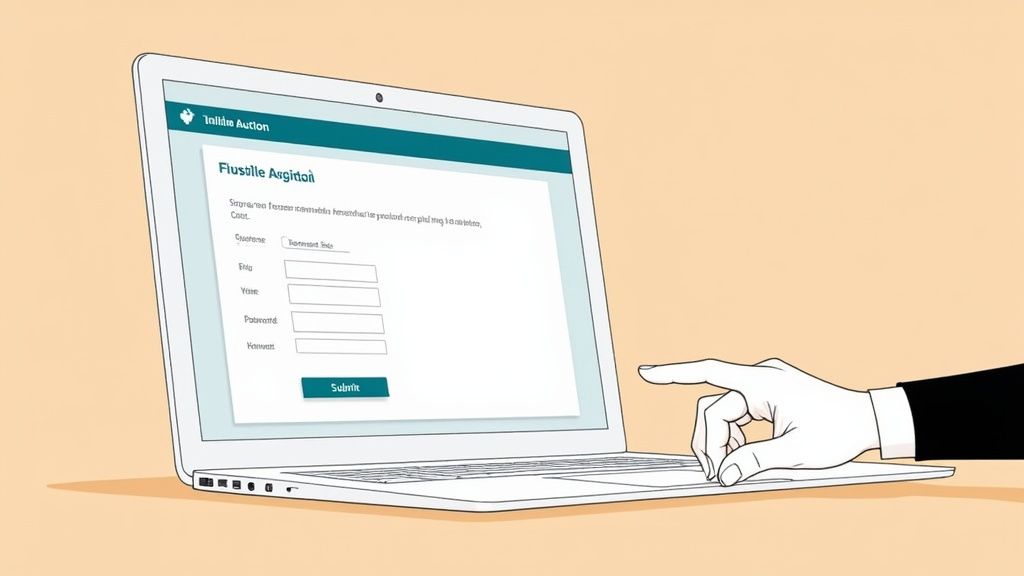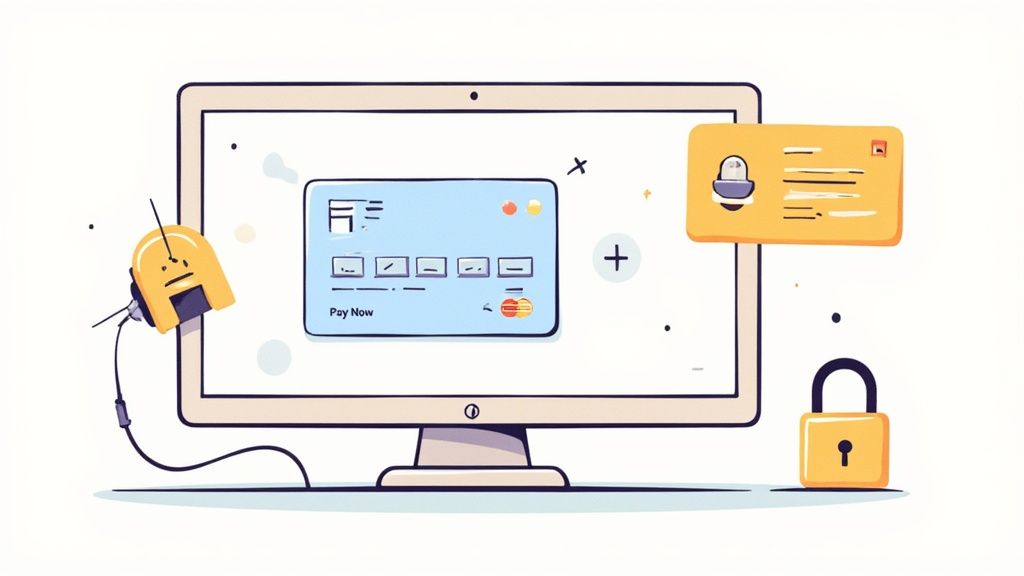An online auction is simply a marketplace on the internet where goods and services are sold to the person who bids the most. A seller puts an item up for sale, defines how long the auction will run, and then buyers place bids electronically. When the clock runs out, the highest bid wins. It's that straightforward.
The Digital Gavel: A Quick Look at How Online Auctions Work

Think of a classic auction house—the fast-talking auctioneer, the raised paddles, the buzz in the room. Now, picture that entire experience happening online, with bidders from all over the world competing from their laptops and phones. That's the heart of an online auction: a virtual space where technology connects sellers to a vast, global pool of buyers.
The whole process is driven by an auction platform, which acts as the digital auctioneer, manager, and bookkeeper all at once. This software is the engine that handles everything from the initial item listing to collecting the final payment. The first step to understanding how an online auction works is to know the three key players involved.
The Core Participants
No matter how big or small the auction, or what's being sold, it always comes down to three essential roles. Each one has a specific job that keeps the digital marketplace moving.
- The Seller: This is the person or company putting an item up for sale. Their job is to write an accurate description, take clear photos, and set the ground rules for the auction, like the starting price and how long it will last.
- The Bidder: These are the potential buyers who want the item. They sign up on the platform, browse what's available, and place bids, hoping to come out on top.
- The Auction Platform: This is the website or app (like eBay or a more specialized service) that hosts the entire event. It provides the digital stage for sellers to list items and for bidders to compete, all while making sure the transaction is safe and secure.
Think of the platform as the neutral middleman where supply meets demand. It's the technology that automates the whole bidding war, tells you when someone has outbid you, and officially names the winner when time is up.
To make it even clearer, let's break down these roles in a simple table.
Core Components of an Online Auction
Here's a quick overview of the essential elements involved in any online auction.
| Component | Role and Function |
|---|---|
| Seller | Lists the item, provides details and photos, and sets the auction rules. |
| Bidder | Registers, views items, and places competitive bids to win. |
| Auction Platform | Hosts the listing, manages bids in real-time, and processes the final sale. |
Every successful auction relies on these three components working together seamlessly. The seller provides the goods, the bidders create the demand, and the platform provides the trusted environment for the sale to happen.
Decoding the Different Types of Online Auctions
To really get a handle on how online auctions work, you have to know that they aren't all cut from the same cloth. Different items and sales goals call for different playbooks, which has led to a few popular auction formats. Each one creates its own unique bidding environment with a distinct pace and psychology.
The one most people recognize is the English Auction. This is where the price starts low and climbs with every new bid. Picture a classic live auction for a rare comic book. Bidders compete out in the open, pushing the price up bit by bit until only one person—the highest bidder—is left when the clock runs out. This format is fantastic for figuring out the true market value of unique or high-demand items.
The Reverse Price Drop
On the flip side, a Dutch Auction operates in reverse. Instead of starting low, the auction kicks off with a high price that the seller systematically lowers until a bidder finally accepts it. This format is a lifesaver for sellers who need to move a large quantity of identical items, fast. Think of a batch of 100 graphic t-shirts. The first bidder to jump in agrees to the price and can often buy as many as they need right then and there. It becomes a race against time, because if you wait too long for a lower price, someone else might swoop in and buy the whole lot.
The core difference here is urgency. English auctions build excitement as prices rise. Dutch auctions create pressure as prices fall, forcing buyers to gamble on how long they can wait for a better deal.
The infographic below paints a clear picture of the incremental bidding that drives the most common type of online auction.

This visual shows exactly how each bid in an English-style auction must be higher than the one before it, pushing the price upward one step at a time.
When Bids Are Kept Secret
Finally, we have the Sealed-Bid Auction, which you might also hear called a first-price sealed-bid auction. In this format, every participant submits their best offer in total secrecy. There's no back-and-forth bidding war; everyone gets just one shot to get it right. Once the auction closes, all the bids are opened, and the highest one wins. This type is often used for things like government contracts or high-value real estate, where careful strategy and accurate valuation matter more than competitive heat.
To help you sort out which format works best for different situations, here’s a quick side-by-side look.
Comparison of Online Auction Formats
Each auction type has a specific job to do. This table breaks down how they work and where they shine.
| Auction Type | How It Works | Best For |
|---|---|---|
| English Auction | Bids start low and increase; the highest bidder wins. | Selling unique, rare, or collectible items. |
| Dutch Auction | Price starts high and decreases until a bidder accepts. | Quickly selling multiple identical items in bulk. |
| Sealed-Bid Auction | Bidders submit one secret bid; the highest bid wins. | High-value sales where strategy is key, like contracts. |
By understanding these mechanics, you can confidently navigate the digital marketplace whether you're buying or selling. It’s all about picking the right arena to achieve your goals.
The Technology Driving the Bidding Frenzy

To really understand how an online auction works, you have to look past the screen and into the engine room powering the whole operation. Every second, millions of bids, listings, and payments fly around the internet. This whole dance is only possible because of some seriously powerful, specialized software.
Think of this software as the ultimate auctioneer and security guard all rolled into one. It’s responsible for listing items, tracking bids in real-time, and securely handling the money once the digital gavel falls. This is the core tech that makes everything tick.
And it's a big business. The online auction software market was valued at USD 2.75 billion in 2025 and is on track to hit USD 4.48 billion by 2033. If you want to dig into the numbers, you can find more details about the online auction software market here.
The Rise of Intelligent Bidding
Modern platforms aren't just managing bids anymore; they're getting smarter. Artificial intelligence (AI) is being woven into the fabric of these auctions to make them safer and more intuitive, and it's something you can actually feel as a user.
AI algorithms are constantly at work, improving the auction in a few key ways:
- Fraud Detection: AI is like a digital bloodhound, sniffing out weird bidding patterns. It can spot things like shill bidding, where fake bids are placed to artificially jack up the price.
- Personalization: The system learns what you like to look at and bid on. Then, it starts suggesting other items you might find interesting, creating a shopping experience that feels like it was built just for you.
- Market Insights: Sellers get a huge boost from analytics that show which items are hot. This helps them price their goods competitively and get a real sense of what the market wants.
This technology acts like a digital detective, constantly monitoring the marketplace to ensure fairness and build trust between buyers and sellers. It’s a crucial layer that helps protect everyone involved from common scams.
The Mobile Revolution and Connectivity
The final pieces of this tech puzzle are mobile apps and high-speed internet. The move from desktop-only websites to slick mobile apps has completely changed who can join an auction and from where.
An auction for a vintage watch is no longer limited to people sitting at a computer. It's now open to someone on a bus, in a coffee shop, or anywhere with a signal. This combination of powerful software, AI, and constant connectivity has turned online auctions from a niche hobby into a massive, global marketplace that fits right in your pocket. Building and maintaining these complex systems requires serious expertise, and you can learn more about the technical proficiency needed for such projects.
Of course. Here is the rewritten section, crafted to sound like it was written by an experienced human expert.
Navigating the Pros and Cons of Digital Bidding
Let’s be honest, online auctions are incredible. They open up a world of possibilities, giving you access to items you’d likely never find in a local shop. The convenience is a massive draw—you can bid on a rare collectible from your couch and potentially score a fantastic deal without even putting on shoes.
But to really understand how an online auction works, you have to look at both sides of the coin. It’s not all just about the thrill of the win.
The single biggest advantage is the sheer scale of it all. You're no longer hemmed in by geography. This global reach means a staggering amount of variety for buyers and a much larger pool of interested bidders for sellers. In the end, this often leads to fairer market prices for everyone involved.
Still, that digital convenience comes with its own set of challenges. To bid smart, you have to know what they are.
The Major Benefits
It's no surprise that digital bidding has exploded in popularity. The advantages are pretty clear and appeal to everyone from casual shoppers just looking for a bargain to serious, hardcore collectors.
- Global Access: Forget your local market. You can find and bid on items from sellers all over the world, dramatically expanding your options.
- Convenience and Flexibility: Participate in an auction whenever you want, from wherever you are, right from your computer or phone.
- Potential for Great Deals: Online platforms often have less overhead than brick-and-mortar auction houses. This can translate into lower prices and the chance to uncover some truly hidden gems.
This shift toward digital platforms is fundamentally changing how we buy and sell. In fact, market forecasts predict the global online auction sector will grow by about USD 3.98 billion between 2025 and 2029. That kind of growth shows just how much consumer behavior is moving away from traditional auction formats. If you're interested in the numbers, you can read the full research about these market trends.
The Common Risks to Avoid
While the opportunities are exciting, the digital format also opens the door to some nasty risks. Simply being aware of them is the first and most important step toward protecting yourself.
One of the most frustrating issues you might run into is shill bidding. This is where a seller, or someone they know, uses fake accounts to place bids on their own item. Their only goal is to artificially inflate the final price, hoping to trick legitimate bidders like you into paying more than you should.
Take a look at the screenshot below. It shows a typical bidding interface from a major platform like eBay, where you can see the bids placed over time.
This bid history is your best friend. It lets you see the bidding patterns, which can sometimes help you spot suspicious activity. For instance, if you see a brand-new account that's only bidding on items from one specific seller, that's a major red flag. Always, always check a seller's feedback history and ratings before you even think about placing a bid.
If you remember nothing else, remember this: the most crucial rule of online bidding is to never get swept up in a "bidding war." When emotions take over, you almost always end up overpaying. Decide on your absolute maximum price before you start, and stick to it no matter how tempting it is to go "just one more."
Strategies for Winning Your Next Online Auction
Knowing how an online auction works is one thing. Actually winning—and winning consistently—is a whole different ball game. Success isn't just about having the deepest pockets. It's about skill, timing, and walking in with a solid game plan before the first bid is even placed. With the right approach, you can seriously boost your chances of snagging the items you want without that dreaded feeling of overpaying.
One of the most effective strategies is also one of the simplest: figure out your maximum bid ahead of time and commit to it. Do a little digging on the item's market value, decide the absolute most you're willing to part with, and lock in that number. This single step prevents you from getting swept up in the emotional rollercoaster of a bidding war, which almost always ends in buyer's remorse.
Master Your Bidding Tactics
To get a real edge, you need a few key bidding methods in your toolkit. Each one has a specific purpose, so knowing which to use and when is what separates the pros from the amateurs.
- Proxy Bidding: Most auction sites offer this as an automated feature. You just enter your maximum bid, and the platform’s system will automatically place bids for you in small increments. It only bids enough to keep you in the lead, all the way up to your pre-set limit. It’s a fantastic "set it and forget it" strategy that means you don't have to be glued to your screen.
- Bid Sniping: This is the fine art of dropping your winning bid in the final, dying seconds of the auction. When done right, it gives your competitors zero time to react with a counter-bid. While incredibly effective, it demands precision and a rock-solid internet connection. Bid a second too late, and you could miss out entirely.
The heart of any good strategy is discipline. Whether you let proxy bidding do the work or you swoop in with a last-second snipe, the goal is the same: stick to your budget and keep emotions out of the driver's seat.
Research Is Your Best Weapon
Never, ever place a bid without doing your homework first. The most successful bidders are always the most informed ones. Before you even think about bidding, you need to thoroughly investigate both the item and the seller.
Start with the seller's reputation. What's their feedback score? What do recent reviews say? How long have they been active on the platform? A seller with a long, clean history of positive feedback is a much safer bet. At the same time, you should be scrutinizing the item description and photos for any potential red flags. If something seems off or unclear, don't be shy—ask the seller a direct question.
Think of it this way: just as a smart business carefully vets its partners and marketing avenues, you should be just as selective with your sellers. For anyone interested in that parallel, our guide on how to choose the right digital marketing channels for your business shows how this same careful selection process pays off in other areas, too. It’s a skill that translates.
The Future of Bidding: Online Market Trends
The world of online auctions has exploded. What was once a small corner of the internet is now a massive global industry, and it's not slowing down. This isn't just a flash in the pan; it's a real shift in how we buy and sell, pushed forward by widespread internet access, a huge cultural move towards sustainable, second-hand goods, and some seriously powerful tech. The digital gavel is only getting louder.
The numbers behind this growth are pretty staggering. In 2023, the global online auction market was valued at around USD 5.25 billion. By 2032, it's expected to more than double, hitting USD 11.3 billion. That’s a compound annual growth rate (CAGR) of 8.7%, which points to a major change in where people are choosing to spend their money. If you want to dig deeper, you can explore more about the factors driving this market growth on dataintelo.com.
The Tech Fueling the Future
New technology is the rocket fuel here, making the whole experience feel more real and interactive. The rollout of 5G technology, for example, is a complete game-changer. It delivers the blazing-fast, low-latency connection you need for things like live-streamed auctions to run without a hitch. Think about it: you could be bidding on a piece of art while watching the auctioneer in real-time, with absolutely no lag.
This kind of tech bridges the gap between a physical auction house and your screen. It creates a vibe that's more engaging and trustworthy, letting bidders feel the energy of a live event from literally anywhere on the planet.
This mix of easy access and high-tech performance is completely changing the game. Of course, the background infrastructure needed to run these platforms is also getting more complex. Keeping pace with these changes is a must for any business operating online, a point we touch on in our article about key IT support trends for 2025. As these technologies get better, they'll keep polishing the online auction experience, connecting more buyers and sellers in more exciting ways. The future of bidding isn't just online—it's live, interactive, and open to everyone.
Common Questions About Online Auctions
Once you start getting the hang of online auctions, a few questions almost always bubble up. You start wondering about the "what if" scenarios or how to bid on pricier items without getting burned. Getting solid answers to these common questions is what separates a nervous bidder from a confident one. Let's tackle some of the most frequent queries head-on.
One of the biggest concerns new bidders have is simple: what happens if someone wins but doesn't pay? If you're the winning bidder and you flake on the payment, the seller can open an "unpaid item" case against you. This usually puts a strike on your account. Rack up a few of these, and you could face bidding restrictions or even get kicked off the platform entirely. The rule of thumb is straightforward: only bid if you fully intend to buy.
Bidding and Buying Safely
A huge question for many revolves around buying high-value items. Is it safe? Absolutely, but you have to be extra diligent. Think of your research as your first line of defense.
- Scrutinize the Seller: Don't just glance at their rating; dive into their profile. Check their overall feedback score, read the most recent reviews, and see how long their account has been active. A seller with a long, positive track record is always a good sign.
- Use Protected Payments: Always stick to payment methods that give you some form of buyer protection. Credit cards and integrated payment systems like PayPal are your friends here. They can help you get your money back if an item doesn't show up or is wildly different from the description.
- Seek Authentication: When you're looking at luxury goods, art, or rare collectibles, check if the platform or seller offers third-party authentication. This is an expert's guarantee that you’re buying the real deal.
The golden rule for online shopping applies tenfold in auctions: if a deal on an expensive item seems drastically too good to be true, it almost certainly is. Always trust your gut.
Understanding Key Bidding Features
Another area that trips people up is the bidding technology itself, especially automated tools like proxy bidding. It's a game-changer once you understand it.
Proxy bidding is an automated feature where you tell the platform the absolute maximum price you're willing to pay. The system then automatically places bids for you, but only just enough to keep you in the lead. Your maximum price is kept completely secret from everyone, including the seller. This is your best weapon against getting swept up in emotional, last-minute bidding wars that make you overpay.
Ready to build a powerful online platform that engages users and drives results? The experts at KP Infotech specialize in creating high-performance web and mobile applications tailored to your business needs. Discover how our development services can bring your digital vision to life.
